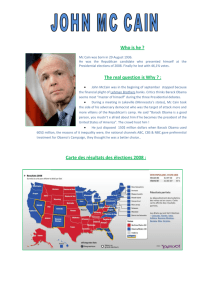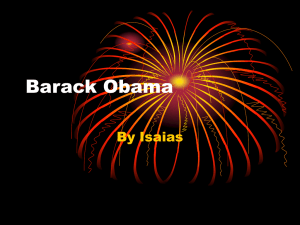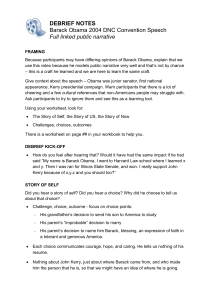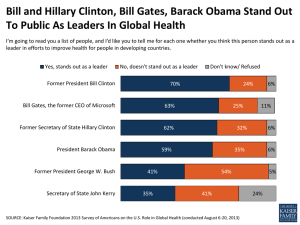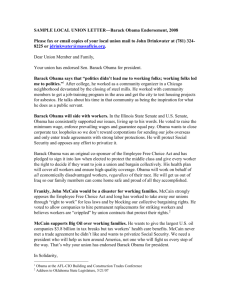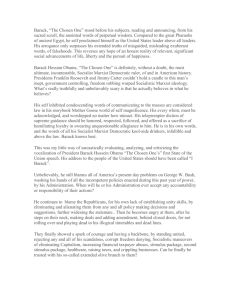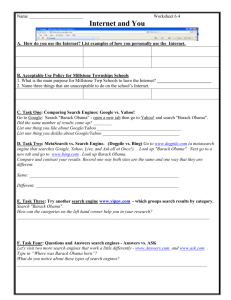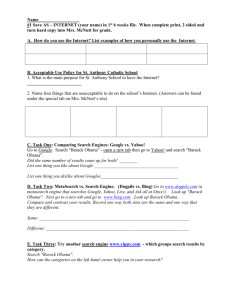an analysis of metaphors that are used by barack obama in his
advertisement
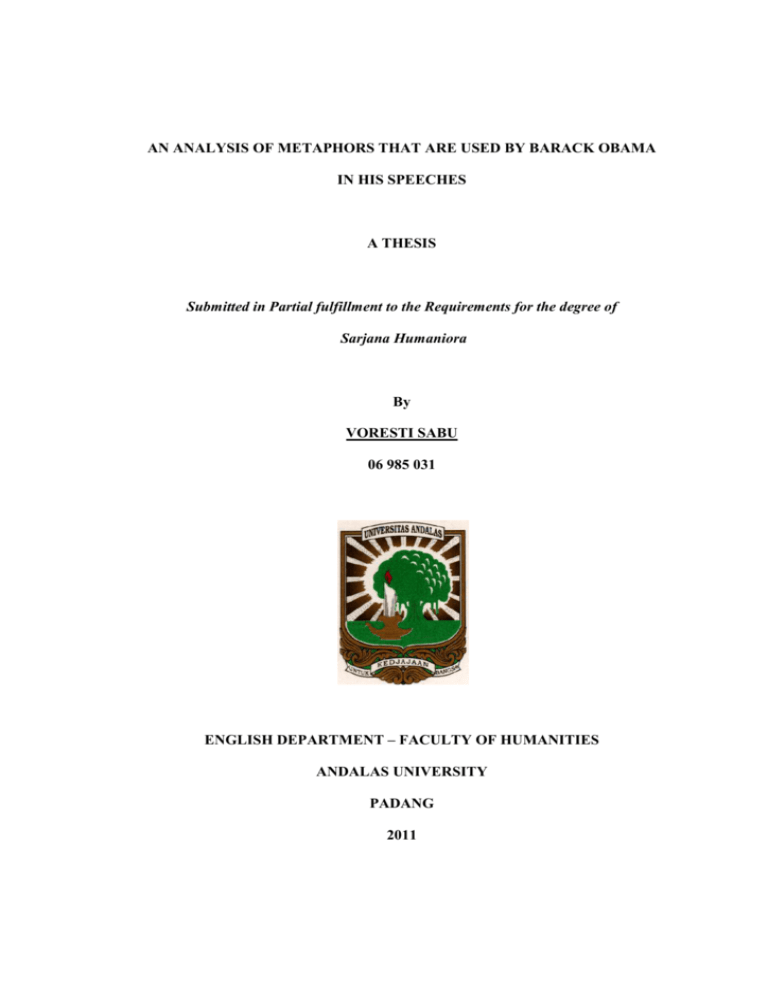
AN ANALYSIS OF METAPHORS THAT ARE USED BY BARACK OBAMA IN HIS SPEECHES A THESIS Submitted in Partial fulfillment to the Requirements for the degree of Sarjana Humaniora By VORESTI SABU 06 985 031 ENGLISH DEPARTMENT – FACULTY OF HUMANITIES ANDALAS UNIVERSITY PADANG 2011 ABSTRAK Dalam skripsi ini penulis membahas tentang metafora yang terdapat dalam pidato Barack Obama. Tujuan penelitian adalah untuk mengetahui makna dan fungsi dari metafora tersebut. Dalam hal ini penulis menggunakan teori yang dikemukakan oleh beberapa ahli yaituLevinson (1983), Ullman (1962), Data diambil dari dua naskah pidato Barack Obama yaitu pidato di GPO House Issues Conference pada tanggal 29 January 2010, dan pidato Barack Obama di Reforming Wall Street pada tanggal 22 April 2010. Metode pengumpulan data adalah metode observasi dan teknik catat. Metode yang digunakan dalam menganalisis data adalah padan pragmatik. Selanjutnya hasil analisis disajikan dengan menggunakan metode formal dan informal. Dari hasil analisis ditemukan 6 metaphor dalam transkrip pidato Barack Obama. Metafora yang digunakan oleh Barack Obama dalam membangun retorika adalah dengan membandingkan kata yang dikenal dalam budaya Amerika dengan kondisi Amerika saat itu, terutama kondisi ekonomi Amerika. Strategi ini mengidentifikasikan bahwa dengan menggunakan metafora pendengar akan lebih terkesan, tertarik dan memahami isi pidato Barack Obama. CHAPTER 1 INTRODUCTION 1.1 Background of the Study Language is one of the most important aspects in human life, because in running activities people cannot avoid using language. People communicate each other by using language. It is used more than for delivering what speakers want to say to the hearers. By using language, one can interact with others and express what he feels. Leech (1981: 40) explains that besides having a informal function which everyone tends to assume that it is most important, language also has expressive function which is used to express the speaker’s feeling. Language is also used in political field. Of course it is different from daily language. The language in politics is a practice of communication of how to use language efficiently to reach all of the social classes. Politics is inevitably connected to power. “Politics is concerned with power to make decision, to control resources, to control other people’s behavior and often to control their values”, (Thomas, et. al, 2004: 38). Politics can be defined as all of the activities in seizing and defending power. The power of political speech is established and maintained by the powerful role of language. One of the goals of politicians is to persuade their audience of validity about their basic claims. Language can be used to influence people’s political and ideological views by exploring in detail the ways in which politicians can use language for their own advantage. Persuasive political phrases must necessarily be creative by the ability to adapt the rhetorical method in order to compete for attention. Charterls Black (2005: 13) stated that, ideology, myth and metaphor are similar in that they share a common discourse function of persuasion. The language that is used by politician is known as rhetoric. Rhetoric means the persuasive speaking of someone who has a purpose to attract people to follow and to agree with his idea. Rhetoric is the art of persuading others, therefore rhetoric and persuasion are inseparable since any definitions of rhetoric necessarily include the idea of persuasion. The essential difference between the two is that rhetoric refers to the act of communication from the hearer’s perspective while persuasion refers both to the speaker’s intentions and successful outcomes (Charterls Black, 2005: 8-9). Therefore audiences are only persuaded when the speaker’s rhetoric is successful. To conduct this research, the writer intends to analyze two speeches of Barack Obama during 2010. Two of the Barack Obama rhetoric speeches were chosen to be analyzed. The rhetoric speeches of Obama were chosen because Barak Obama as one of the United States of America’s president is well known as figure that has skill and style in conveying a good speech in front of public. As president he has done his speech in order to persuade the audiences. In delivering his speech Obama has good language in uttering his speech. His speeches have directed all of hearers in America, even more, most people in the world. Actually there are many topics of Presidential speech of Barack Obama, but for this research the writer takes two rhetoric speeches during 2010 as the source of data. Then, this research relates to the style of persuasive language in persuading the audience that was used by Barack Obama, especially metaphor. Here, the writer entitled this study “An analysis of metaphor that was used by Barack Obama in his speeches” 1.2 Identification of Problem This research will analyze metaphors in Barack Obama’s speech in his rhetoric speeches. To obtain the aim of this research the writer proposes two questions: 1. What are the meanings of the metaphors that were used by Barack Obama in his rhetoric speeches? 2. What are the functions of metaphors that were used by Barack Obama in his rhetoric speeches? 1.3 Objective of the Study This writing aims to find out the meaning and function of Barack Obama’s metaphors in his rhetoric speech. 1.4. The Limitation of the Study In this research, the researcher makes some limitation. There are so many rhetoric speeches of Barack Obama. In this study the data are taken by the researcher from two of Obama’s speeches in 2010. The researcher also concerns on 2 points of view. They are: analyzing metaphors in Barack Obama rhetoric speech proposed by Levinson, and finding out the meaning of metaphors themselves. 1.5. Method of the Research In conducting this research, the researcher follows several steps to process the data which steps is proposed by Sudaryanto (1993: 57), they are: 1. Collecting the Data The source of the data is taken from a script of the U.S Presidential speech in website http://obamafoodorama.blogspot.com/2010/11/transcript-president- obamas-speech-in.htmle. In collecting the data, the writer used observational method, which is the method of collecting data by doing an observation of the language that is used in this research directly. The technique that she used is non-participatory observational technique. She also used note-taking technique, which is a technique by taking note for all the data that is found (Sudaryanto, 1993: 135). In the process of collecting the data, here are some procedures which have been done. The writer has attempted to discover two transcripts of the U.S Presidential Speech during 2010 in internet to be analyzed. Then, the writer reads the transcript of the speech repeatedly in several times and identifies metaphor in it. After that, the researcher analyzes the meaning of metaphors that are used by Barack Obama based on Levinson’s theory (1983) and the function of metaphors from the data that have been selected. 2. Analyzing the Data In this research the researcher analyzed the data using distributional method as proposed by Sudaryanto (1993). Distributional method is determining tool part of the language itself. In analyzing the data, the writer uses some steps; they are; (1) Identifying the data that are needed for this research, (2) Classifying the data based on the metaphor in pragmatic (3) analyzing the data based on the theory that is used. Considering by the theories that will be used to analyze the data, the researcher uses theory of Levinson to figure it out. 3. Representing the Result of the Data Analysis The result of analysis is presented by using informal method. As proposed by Sudaryanto (1993: 145), informal is the way of presenting the finding of analysis by using the verbal language. And the formal method is used by the researcher in presenting the data by using table. CONCLUSION This writing focuses on a specific element of Obama’s rhetoric skill – the use of metaphor. This writing deals with the theory of metaphor. The writer tries to apply this theory by examining 6 data. The metaphor that are used by Obama – freeze, Holy Grail, battalions, etc are familiar by audience and him because those words are influenced by culture and condition of America. The metaphor itself is used by Obama to compare with the condition of America at that time generally and especially in economic condition. Based on the analysis, metaphor cannot be understood literary. The presence of the text of situation is very important in getting the message. The meaning of metaphor in those speeches cannot be separated from the topic of tat speech. It is difficult to know and get the real meaning conveyed in that figurative language without considering the presence of the context of situation. The context guides the writer in understanding and getting the message of that metaphoric expression. It is also being known based on the analysis that each metaphor has its own function in the text which can give more understanding. By observing the 6 data, the writer concludes principles account of the metaphor, they are: metaphor can be paraphrased as comparison statements; statements need not to be false or semantically deviant to be perceived as metaphorical; metaphor can be recognized as such because they can be implicity transformed into comparison. The writer concludes that the function of metaphor used by Obama in his rhetoric speech as a tool to clarify meaning, to inspire, and to motivate the audience. Metaphor in Obama’s speech can be used to convey emotional meaning which then may attract audience’s attention. By using metaphor, Obama’s speech may be more inspiring because Obama can handle emotional connection with the topic while conveying the message. However, the function of metaphor in Barack Obama’s rhetoric speech is same as rhetorical strategies which have the persuasive effect of strengthening of message. BIBLIOGRAPHY Barack Obama Speech – Open Forum at GOP House Issues Conference delivered 29 January 2010, Baltimore, Maryland. http://www.americanrhetoric.com/speeches/barackobama/barackobamagopho useissuesconference.htm Retrieved: March 17, 2011 Barack Obama – Reforming Wall Street. delivered 22 April 2010, Cooper Union, NewYork,NY http://www.americanrhetoric.com/speeches/barackobama/barackobamareform ingwallstreet.htm. Retrieved: March 17, 2011 Burnes, Susan. 2011. Metaphor in Press Reports of Elections: Obama Walked on Water, But Musharraf Was Beaten By A Knockout. Journal of Pragmatics. Http: Www.Elsevier.Com/Located/Prgma Retrieved: June 18, 2011. Capone, Alessandro. 2011. Barack Obama’s South Carolina speech. Journal of Pragmatics. Http: Www.Elsevier.Com/Located/Prgma Retrieved: June 18, 2011. Chartlerts-Black, Jonathan. 2005. Politicians and Rhetoric: The Persuasive Power of Metaphor. New York: Palgrave Macmillan. Glucksberg, Sam. 2001. Understanding Figurative Language: From Metaphors To Idioms. Oxford. University Press. Holme, Randal. 2004. Mind, Metaphor And Language Teaching. Great Britain: Penguin Books. Jeffery, et al. 2005. Presidential leadership and charisma: the effects of metaphor. Journal of pragmatics. http://www.sciencedirect.com Retrieved: February 28, 2011. Lakoff, George and Mark Jonson. 1980. Metaphor We Live By. Chicago: The University Of Chicago Press. Knowles, Murray and Moon, Rosamund. Introducing Metaphor. 2006. Routledgr 2 Park Square, Milton Park, Abingdon Leech, Geoffrey. 1981. Semantic: The Study of Meaning. 2th Ed. Great Britain: Penguin Books. Levinson, Geoffrey. 1983. Principle of Pragmatic. Cambridge: Cambridge University Press. Oxford, University Press. 2005. Oxford Advanced Learner’s Dictionary. Oxford Renton. N.E. Metaphorically Speaking: A Dictionary of 3,800 Picturesque Idiomatic Expressions / N.E. Renton. 1990. America. Warner Books Edition. Sudaryanto. 1993. Metode dan aneka teknik analisis bahasa: pengantar penelitian wahana kebudayaan secara linguistic. Yogyakarta: duta wacana univerdity press. Thomas, Linda. Et al 2004. Language, society and power. New York: rountledge Ullman, Stephen. 1962. Semantic: An Introduction to the Science of Meaning. Oxford: Basil Blackwell. Yule, George, 1996. Pragmatics. Oxord: Oxford University Press
